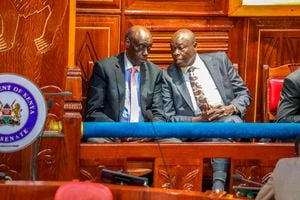Pastoralists find a saviour in Takaful Insurance of Africa

Ms Sumayya Hassan, the Chief Executive Officer of Takaful Insurance of Africa.
Takaful Insurance of Africa (TIA) launched an Index-Based Livestock Takaful (IBLT) project in 2013, targeting pastoralists in Arid and Semi-Arid Lands (Asal), a risk management plan that helps reduce losses occasioned by drought. Takaful CEO Sumayya Hassan spoke to Sammy Waweru
The effects of climate change in the Horn of Africa are evident and TIA is stepping in to offer a reprieve. What are some of your programmes?
TIA offers the IBLT product that was designed and developed to drive market-mediated and index-based products with the aim of protecting livestock keepers, particularly in Asal.
IBLT is the first shariah-compliant index-based livestock insurance policy that combines a financial risk mitigation instrument, with innovative use of satellite imagery to provide pastoralists with funds to buy supplement feed.
Through measuring the quality of pastureland, the data shows when forage is impaired to the point of endangering livestock. When this occurs, TIA pays policy-holding pastoralists, allowing them to manage their individual risk.
What is the aim of the IBLT?
The objective is to reduce poverty, promote asset-retention and accumulation among beneficiaries. Its primary function is to act as a resilience measure and safety net during drought, offering a fairly effective solution to families in Asal against the worst effects. It provides them money to buy substitute fodder that will keep their animals alive during periods of severe calamity. This has been shown to have a significant impact on long-term livelihoods and asset-protection of pastoralists.
How many counties are you running the programme? What is the uptake since it was launched a decade ago?
IBLT is being offered in Wajir, Garissa, Isiolo, Marsabit, Moyale, Mandera, Tana River, Samburu and Turkana counties. More than 40,000 pastoralists have taken up the programme, through voluntary purchase as well as through financial assistance in the form of partial or full subsidies by our donor partners.
Do you intend to expand the programme to other regions?
If needs in those counties require a similar intervention, we will do so. Meanwhile, we have been undertaking an intensive research and development scheme with the aim of revamping and improving the IBLT, offering to make it more responsive to the needs of participants.
The government through the State Department for Livestock tried this, including animal off-takes in drought-prone regions, with little impact. Locals say the plans are made in boardrooms with no consultation. How different is IBLT?
A significant difference in our approach is that we undertake last-mile engagement ourselves. We have a wide network of agents on the ground in the areas IBLT is offered. Our agents and champions are from the communities. They speak to the people in their own language and understand the culture and dynamics. This has been key to successful engagement.
Your company conducted a survey in several Asal counties in 2022. What were the findings?
We conducted the study in five counties where IBLT uptake has been highest – Garissa, Wajir, Mandera, Isiolo and Samburu.
We gathered information on what matters most to our participants. This goes in hand in hand with what they value most, how they perceive the IBLT, livelihood plans they would like to take part in and additional useful products.
Reversing the effects of drought may not happen soon even as the government embarks on a nationwide tree-planting drive. Wouldn’t establishing feeding lots in dry lands offer an immediate solution?
The effects of global warming are felt in every part of the world. It is unfortunate and ironic that countries like Kenya, which produce the least greenhouse gases, are disproportionately affected by the worsening conditions. Stopping the negative effects of climate change will require a global commitment.
However, there are interim programmes that can cushion the most vulnerable communities, including pastoralists, from loss, poverty and even death. Feeding lots is one of them.
Other mitigation measures are construction of pans and dams to harvest rain water and providing the means and training to enable pastoralists engage in alternative livelihoods, thus reducing reliance on livestock.
Is Kenya the first country to benefit from your programme? If not, where else is IBLT?
Kenya is the first country.
Does TIA encourage pastoralists to diversify so as to end the cycle of poverty brought about by reliance on livestock, bearing in mind that cows, sheep, donkeys, goats and other animals are wiped out by droughts almost every year?
We acknowledge that pastoralism remains an important cultural livelihood for millions of people, most of whom are cash poor and depend entirely on the well-being of their herds.
Nevertheless, encouraging diversification is a significant focus for TIA. We do this through our intricate grassroots network of agents, partnerships with like-minded organisations, radio and TV programmes, at market places and other forums where we sensitise and encourage pastoralists to take up training and join available programmes that will equip them with the necessary skills to undertake alternative projects.
We also encourage them to participate in livestock offtakes to reduce their herds to a manageable size, thus reducing the strain on the family, community and resources during periods of severe drought.
These initiatives are usually very technical, broad and expensive to implement and require the collaborative efforts of the government – both national and county – donor agencies, NGOs and the private sector.
TIA remains willing and available to partner in finding lasting solutions to this difficult and perennial problem.





